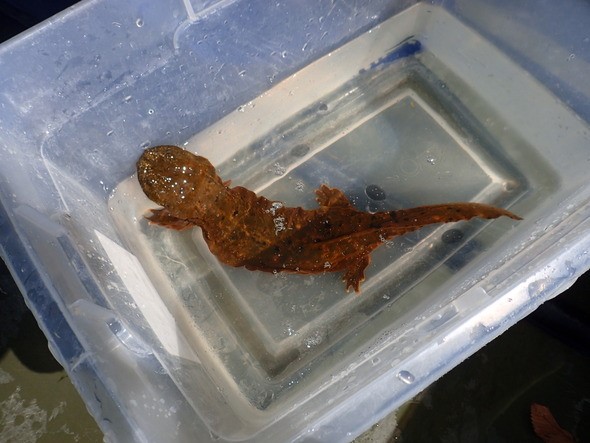JEFFERSON CITY, Mo. – Roughly a year after a zoo-reared Ozark hellbender successfully fathered a clutch of eggs in the wild, an eastern hellbender has followed suit. The Missouri Department of Conservation (MDC) confirmed the first eastern hellbender raised in human care at the Saint Louis Zoo has reproduced in the wild on the Gasconade River.
The news shows MDC’s partnership with the Saint Louis Zoo to recover hellbender populations is creating a bright future for the endangered Ozark and eastern hellbender in Missouri.
“We couldn’t be more thrilled to confirm this news about the eastern hellbender,” said Missouri State Herpetologist Jeff Briggler. “Seeing successful reproduction of zoo-reared animals in the wild has been our ultimate goal and our hope is this event becomes more common.”
BACKGROUND
In Missouri, the eastern hellbender subspecies occurs in the northern Ozark highlands in spring-fed rivers. Missouri is the only place in the world where both the eastern and Ozark hellbender are found. Both subspecies are listed as endangered by the State of Missouri and the U.S. Fish and Wildlife Service.
Primary threats facing hellbenders are habitat alteration and degradation, over-collecting, disease, predation, and degraded water quality. Hellbenders are long-lived (with a 30-year lifespan), slow-to-mature amphibians that seldom venture far within the river.
MDC partnered with the Saint Louis Zoo WildCare Institute Ron and Karen Goellner Center for Hellbender Conservation and other agencies in the early 2000s to breed hellbenders in human care and rear eggs collected from the wild in order to reverse population declines. Once the zoo-bred larvae reached between 3-8 years old, they are released in their native Ozark aquatic ecosystem. Biologists began releasing a few zoo-reared hellbenders in Missouri in 2008, later increasing the number of released animals to 1,000 or more per year beginning in 2012. Since the conception of the breeding and raising of this animal in human care, more than 12,000 Ozark and eastern hellbenders reared at the Saint Louis Zoo and MDC hatchery have been released into their native rivers.
EASTERN REPRODUCTION
This released, male eastern hellbender originated from the collection of eggs in the fall of 2015 on the Gasconade River by MDC, then transported to the Saint Louis Zoo where the eggs were hatched and reared.
“Rarely are hellbender nests found on the Gasconade River,” noted Briggler. “Therefore, it was a pleasant surprise to even find a nest, but an overwhelming surprise to learn the father was a released animal.”
This male was released into the Gasconade River in June 2018. At the time of his release, he weighed 3.3 ounces (93 grams) and measured 9.3 inches (23.5 cm). At the time he was found guarding a nest in September 2023, he weighed 11.5 ounces (326 grams) and measured 14.7 inches (37.4 cm) in length.
“It’s always exciting to know the history and health of an animal after its release,” said Briggler.
The eight-year-old animal was a father to a clutch of 86 eggs. Upon a nest check in early October, all of the eggs had well-developed embryos with prominent head and tail buds.
The news comes roughly a year after an Ozark hellbender fathered a clutch of eggs on the Current River.
“After discovering incidents of both subspecies successfully reproducing in the wild, I’m confident this is going to be something we see all the time,” said Justin Elden, Curator of Herpetology and Aquatics at the Saint Louis Zoo, and Director of the Saint Louis Zoo WildCare Institute Ron and Karen Goellner Center for Hellbender Conservation. “This conservation effort shows if given support and patience, these animals can take the lead and ensure they’re around for generations to come.”
In addition to the Saint Louis Zoo, MDC partnered with the U.S. Fish and Wildlife Service, U.S. Forest Service, National Parks Service, and the Arkansas Game and Fish Commission to enhance propagation efforts to ensure hellbenders remain a part of Missouri’s biodiversity.
“The goal is to set these animals up for success and a part of that is reproducing on their own,” said Elden. “The nests of the Ozark and now the eastern hellbender are confirmation we’re heading in the right direction and we aren’t going to stop now.”
Read about the zoo-reared Ozark hellbender who was found with a clutch of eggs in the fall of 2022 from the MDC newsroom at short.mdc.mo.gov/4Qj.
To learn more about hellbenders, visit MDC’s online Field Guide at short.mdc.mo.gov/4M9.
Find more about the Saint Louis Zoo WildCare Institute Ron and Karen Goellner Center for Hellbender Conservation online at short.mdc.mo.gov/4MC.







